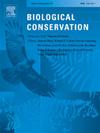From forest floor to market door: The global terrestrial invertebrate trade
IF 4.9
1区 环境科学与生态学
Q1 BIODIVERSITY CONSERVATION
引用次数: 0
Abstract
The global terrestrial invertebrate trade is a prominent wildlife market with considerable ecological, economic, and social implications. Invertebrates are used as a food source, to assist agricultural production, and to increase well-being through entertainment and companionship; however, our understanding of the global invertebrate trade remains limited. Consequently, much of this trade involves the wild harvest of animals without due process to determine sustainable harvest rates. We systematically reviewed the global terrestrial invertebrate trade literature, and identified 96 scientific papers discussing their trade, with the majority (85 %) published after 2010. From this literature, we documented 4315 unique species involved in the international terrestrial invertebrate trade, and identified 17 uses for these species driving the global market. The most common uses (i.e., use-types) included pets, food, and preserved antiquities, while more obscure use-types, such as beetle wrestling, alcohol distillation, and scorpion venom for pharmaceutical research, were also identified. Although this global market presents various threats to biosecurity and biodiversity, it also benefits many human populations, particularly economically marginalised rural communities. We recommend that this trade be more widely included in law enforcement policy and wildlife trade regulation to ensure its sustainability into the future.
从森林地面到市场大门:全球陆生无脊椎动物贸易
全球陆生无脊椎动物贸易是一个重要的野生动物市场,具有相当大的生态、经济和社会影响。无脊椎动物被用作食物来源,协助农业生产,并通过娱乐和陪伴来增加福祉;然而,我们对全球无脊椎动物贸易的了解仍然有限。因此,这种贸易的大部分涉及野生动物的收获,而没有适当的程序来确定可持续的收获率。我们系统地回顾了全球陆生无脊椎动物贸易文献,并确定了96篇讨论其贸易的科学论文,其中大多数(85%)发表于2010年之后。从这些文献中,我们记录了4315种参与国际陆生无脊椎动物贸易的独特物种,并确定了这些物种推动全球市场的17种用途。最常见的用途(即用途类型)包括宠物、食物和保存文物,而更模糊的用途类型,如甲虫摔跤、酒精蒸馏和用于药物研究的蝎子毒液,也被确定。尽管这一全球市场对生物安全和生物多样性构成了各种威胁,但它也使许多人口受益,特别是在经济上被边缘化的农村社区。我们建议将这种贸易更广泛地纳入执法政策和野生动物贸易监管,以确保其在未来的可持续性。
本文章由计算机程序翻译,如有差异,请以英文原文为准。
求助全文
约1分钟内获得全文
求助全文
来源期刊

Biological Conservation
环境科学-环境科学
CiteScore
10.20
自引率
3.40%
发文量
295
审稿时长
61 days
期刊介绍:
Biological Conservation is an international leading journal in the discipline of conservation biology. The journal publishes articles spanning a diverse range of fields that contribute to the biological, sociological, and economic dimensions of conservation and natural resource management. The primary aim of Biological Conservation is the publication of high-quality papers that advance the science and practice of conservation, or which demonstrate the application of conservation principles for natural resource management and policy. Therefore it will be of interest to a broad international readership.
 求助内容:
求助内容: 应助结果提醒方式:
应助结果提醒方式:


